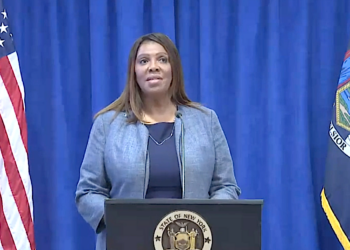Having waited in the shadows of Albany politics, a Thornwood construction company last week was the first business in New York state to let the sunlight in for a new commercial net metering system for renewable energy that could spark other businesses to put mini-power plants on their buildings.
On the first business day after Gov. David Paterson signed net metering bills into law, officials at C.W. Brown Inc. ignored massing storm clouds and flipped the switch on a meter that allows the company to spin excess electricity generated by its 13.6-kilowatt system of rooftop photovoltaic panels into Consolidated Edison Co.”™s supply grid. The panels turn sunlight into direct-current electricity, which is then converted into alternating-current power for use in the company”™s 11,000-square-foot building.
The new law requires utilities receiving excess power generated by solar and wind systems to credit commercial suppliers of power on their electrical bills just as residential and farm generators of renewable energy already are. Utilities previously could opt to buy back or credit renewable power from business customers, though few businesses participated. Under the new law, commercial suppliers are limited in credits to the lesser of 2 megawatts of power or the customer”™s average peak load usage.
Â
”˜Brown Goes Green”™
Charles W. Brown, president of the general contracting and construction company, said the company waited several months for legislation to be enacted before connecting its state-of-the-art solar-panel system with the ConEd grid. Brown said the company expects savings of roughly 25 percent, or $2,800 to $3,000 a year, on its energy bills with the system. The company, which has 22 office employees, expects to generate excess power for the ConEd system especially on Sundays when its building is not in use.
Â
Â
Â
Â
“We”™re really trying to focus our direction for the company on ”˜Brown Goes Green,”™” said company CEO Renee Brown. The solar-panel installation and net metering are part of that broader conservation initiative, which includes recycling construction waste materials, she said. C.W. Brown”™s current building renovation projects include Fordham University”™s new Westchester campus building in West Harrison.
The solar-panel installation cost about $122,400, which was reduced by a $55,000 rebate to the owner from the New York State Energy Research and Development Authority (NYSERDA), said J. Jared Haines, president of Mercury Solar Systems, the New Rochelle company that partnered with C.W. Brown on the project. Haines said the owner can save another $55,000 to $58,000 over the next five years from a 30 percent federal tax credit for renewable energy systems and accelerated depreciation, lowering the total cost to about $12,000. The company will see a payback on its investment within five years, he said.
By harnessing sunlight for its electrical needs, the company will avoid 27,000 pounds of carbon dioxide emissions yearly from fossil-fuel-generated power, Haines said. About one-seventh of solar energy produced at C.W. Brown will go to “neighbors” on the ConEd system, he estimated.
Â
Retail-rate credit
John J. Mucci, ConEd vice president for engineering and planning, said the commercial net metering mandate eliminates the utility”™s cumbersome buyback system for power from commercial providers that required businesses to run two meters. Under the new law, credits for companies will be calculated at the full retail cost of electricity rather than at the utility”™s avoided cost for generation. That latter cost for ConEd is 10 cents to 12 cents per kilowatt hour, compared to a current retail price of more than 20 cents per kilowatt hour, Mucci said.
That retail-rate credit in the new state law brought a warning from the head of a trade group in Albany representing ConEd and four other regulated utilities in the state. Patrick J. Curran, executive director of the Energy Association of New York State, said the credit, which includes a utility”™s service delivery charges, energy taxes and other government-set fees, ultimately shifts those costs to other business and residential customers. By extending the broader credit to large commercial customers, “The cost burden to New York”™s energy consumers could be enormous” if many more companies generate and distribute renewable energy as encouraged by the state and utilities, Curran said.
Â
Â
Â
“It”™s a tricky bit of business,” Curran said. He said the regulated-utilities group lobbied in Albany for the credits cap that effectively limits credits to the peak amount of power used by a business.
ConEd”™s Mucci said the utility welcomed the retail-cost credit “because it really encourages our customers and we conserve” on system demand and infrastructure and construction costs to meet that demand.
Â
Room for solar
Despite the national construction downturn, “In Westchester County they”™re still building like crazy,” Mucci said. ConEd expects electrical demand in its New York City and Westchester service area to grow by about 200 megawatts a year, he said. In July, ConEd sent out a record 6.7 billion kilowatt hours over its power grid, more than the amount of electricity used in Vermont or Alaska for an entire year.
“In Westchester you”™ve got a lot of people with warehouse and roof space,” Mucci said. “That”™s where (a solar-energy system) will work.” Mucci said five or six other businesses in the county are constructing solar-panel systems.
At Mercury Solar Systems, “We have probably $7 million worth of work in Westchester County over the next six months,” said Haines. He said the company has installed clean-energy systems at about 50 homes in the last year. Its commercial clients include PepsiCo Inc. in Valhalla, Morgan Stanley in Purchase, New King Street Associates in White Plains, Excelsior Packaging Group Inc. in Yonkers and i.park Norwalk in Norwalk, Conn.
For a solar-energy installation, “It”™s a lot easier to get an owner-occupied building to make the decision rather than to get a corporation to decide,” said Haines, whose company has grown to 21 employees since opening in September 2006.
“I would say New York is one of the top five states in the country for solar,” he said.


















